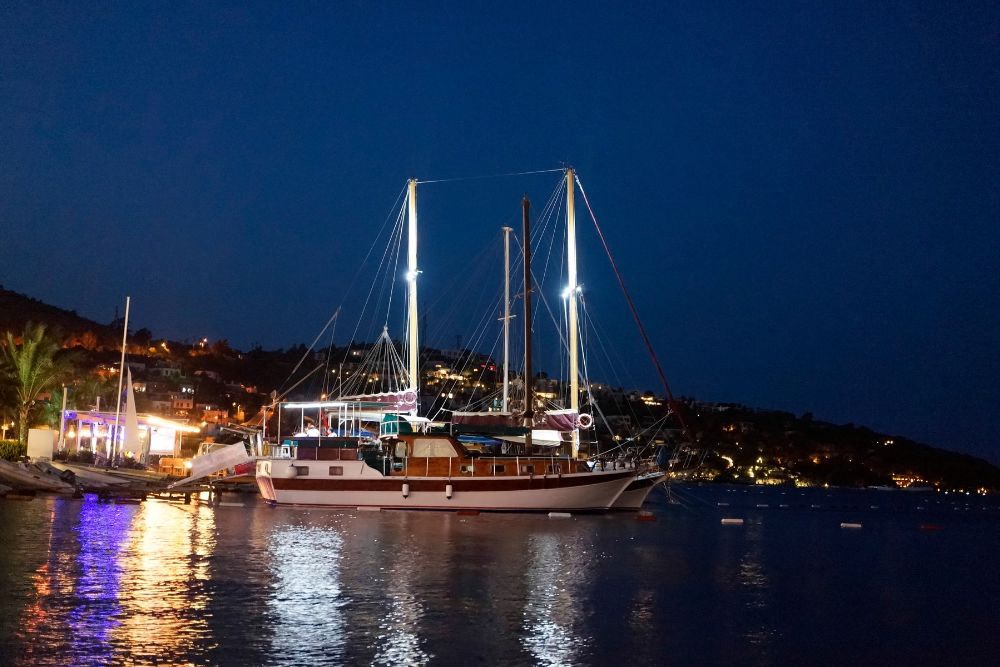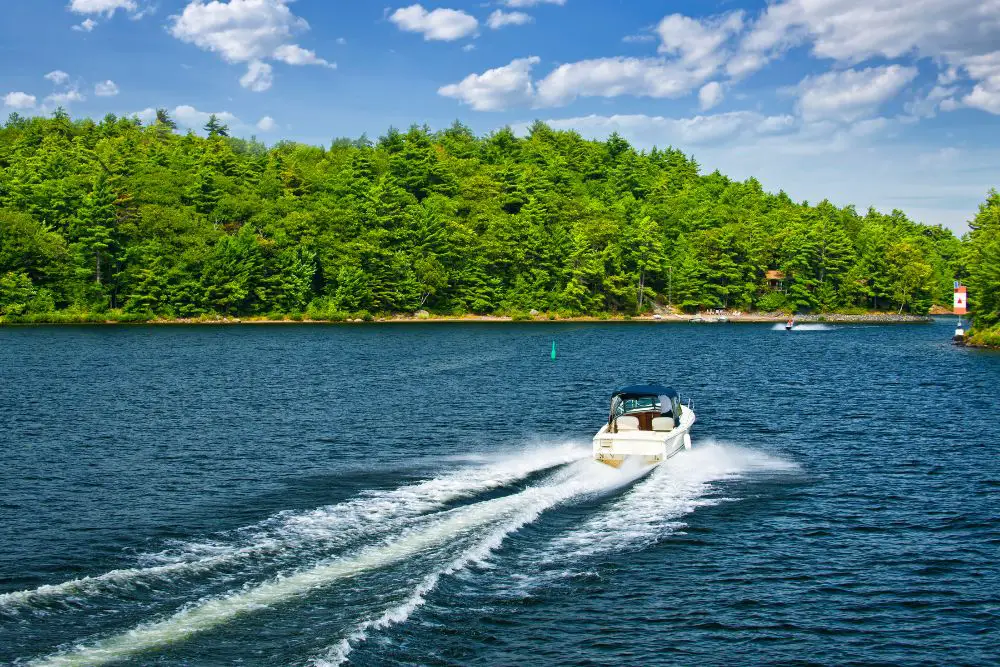Boating at night can be a breathtaking experience. With the stars shining overhead, and the peace of being on the water, it’s no wonder many boaters choose to extend their time on the water well into the evening hours. However, there are a few things you need to know before heading out after sunset. Here are a few tips for nighttime boating safety.
Lights You Will Need On A Boat At Night
Being out on the open water at night can be a peaceful and calming experience. However, it is important to be aware of the safety hazards that come along with nighttime boating. One of the most important safety precautions is ensuring that your boat is properly lit.
Navigation Lights
All boats must display navigation lights between sunset and sunrise. These lights allow other vessels to identify your boat’s position, course, and intentions. Most navigation lights are white, red, or green.
White lights are typically displayed at the bow (front) of the vessel, and green lights are displayed at the stern (rear). Red lights are placed on each side of the boat near the bow and are visible from directly ahead, abeam (to the side), and astern (from behind).
Depending on the size of your vessel, you may also be required to display additional sidelights and stern lights. Make sure your navigation lights are in good working condition before heading out after dark – you don’t want to get pulled over by the Coast Guard!
Running Lights
In addition to navigation lights, boats must also display running lights while underway between sunset and sunrise. Running lights consist of a masthead light (white light visible from directly ahead), sidelights (red and green lights visible from abeam), and a stern light (white light visible from astern). Smaller vessels may combine their sidelights into one all-around light that is visible from all directions.
Docking Lights
These twin beams function in much the same way as headlights on a road vehicle. In fact, you may even hear them referred to as “headlights” in common parlance. Docking lights should be used any time your boat is moving close to other boats or objects in the water, such as docks, piers, or buoys. They help you see and be seen in low-light conditions and should always be used in conjunction with other navigational lights.
What Do The Lights On A Boat Mean?
If you’re new to boating, you might wonder what the different colored lights on a boat mean. In this quick guide, we’ll explain the meaning of the most common colors of boat lights.
Red Lights: Red lights are typically found on the stern (rear) of the boat. They indicate that the boat is underway and can be seen for up to two miles away.
Green Lights: Green lights are typically found on the bow (front) of the boat. They indicate that the boat is underway and can be seen for up to two miles away.
White Lights: White lights are typically found along the boat’s sides. They indicate that the boat is moored (anchored or docked) and can be seen for up to one mile away.
Yellow Lights: Yellow lights are typically found on hazard markers. They indicate that there is a danger ahead and should be avoided.
Red/White Lights: Red/white lights are typically found on buoys. They indicate that there is a danger ahead and should be avoided.
Now that you know the meaning of the most common colors of boat lights, you can confidently hit the water! Just remember, red means stop, green means go, and yellow means caution.
Required Lights When Anchored (Anchor Light)
If you’ve ever been out on a boat at night, you know how important it is to have an anchor light. But what exactly is an anchor light? An anchor light is a 360-degree white light that is required to be displayed on a boat between sunset and sunrise. This light makes the boat visible to other watercraft and helps promote greater safety for everyone involved. In this blog post, we’ll discuss why it’s so important to have an anchor light and how you can make sure yours complies with the law.
Why You Need an Anchor Light
Anchor lights are required by law in many countries, including the United States, Canada, and Australia. The main reason for this is safety. When boats are out at night, it can be difficult for others to see them. This can lead to collisions, which can be very dangerous or even deadly. An anchor light can help make your boat more visible and reduce the risk of collision.
Another reason you need an anchor light is to be sure your boat complies with the law. If you’re caught without one, you could face hefty fines or other penalties. In some cases, you may even lose your boating privileges. So it’s definitely worth it to make sure you have a compliant anchor light on your boat.

Launching A Boat At Night
For many boaters, the thought of launching their vessel after sunset is enough to make them break out in a cold sweat. After all, plenty of things can go wrong when venturing out onto the water in the dark. However, with a little bit of preparation and know-how, launching your boat at night doesn’t have to be a stressful experience. Here are a few tips to help you get started.
Check Your Lights Before You Head Out
Before you even think about launching your boat at night, it’s important to ensure that all your lights are in working order. This includes your navigation lights and any other lights you may need to help you see where you’re going. Once you’re satisfied that everything is in good working condition, it’s time to start getting your boat ready for launch.
Make Sure You Have A Good Flashlight On Hand
Even if your boat’s lights are in perfect working order, it’s always a good idea to have a flashlight on hand when launching at night. This will come in handy if you need to signal for help or if you need to take a closer look at something while you’re on the water. Just be sure to choose a flashlight that is durable and waterproof so that it won’t let you down when you need it most.
Wear Proper Clothing And Footwear
When launching your boat at night, it’s important to dress for the occasion. This means wearing clothing that will keep you warm and dry and footwear that will provide good traction on slippery surfaces. Remember, it’s always better to err on the side of caution when choosing what to wear, so don’t hesitate to layer up if necessary.
Use A Spotter
If possible, have someone help you launch your boat at night. This person can act as a spotter, making sure that you don’t miss any crucial steps in the process. Additionally, having a second set of eyes will help you feel more confident and safe when launching your boat at night.
Check Local Regulations
Before heading out on the water, be sure to check local regulations regarding boating at night. Some areas have specific restrictions or requirements that must be followed in order to ensure the safety of all involved. By familiarizing yourself with the rules ahead of time, you can avoid any potential problems while boating at night.
Check Your Vessel Thoroughly
Before setting out, it’s important to inspect your vessel thoroughly. Ensure all lights are in working order and that there are no potential hazards that could cause problems while you’re on the water. Additionally, it’s a good idea to check the forecast before heading out so that you can be prepared for any inclement weather that may occur.
Go Slowly
When boating at night, it’s important to go slowly and carefully. This will give you more time to react if something unexpected happens and will also help you avoid any potential hazards in the water. Be sure to use extra caution when navigating through narrow passages or areas with limited visibility.
Keep An Ear Out
In addition to keeping an eye out for potential hazards, it’s also important to keep an ear out while boating at night. This means listening for other boats in the area and paying attention to any changes in the weather conditions. By remaining alert and aware of your surroundings, you can help ensure a safe and enjoyable experience while boating at night.
In Conclusion
Boating at night can be a fun and unique experience. However, it’s important to take extra precautions to ensure your safety. By following these tips, you can help ensure that your next outing is enjoyable and incident-free.



